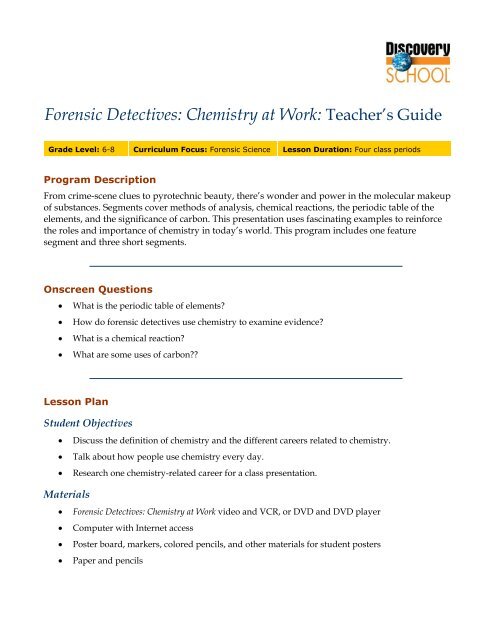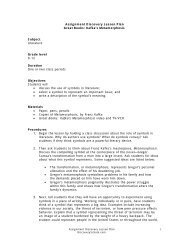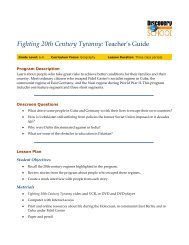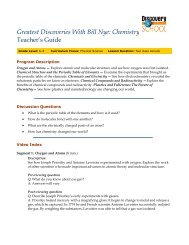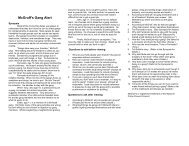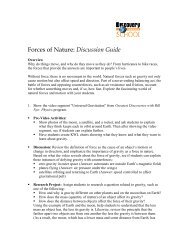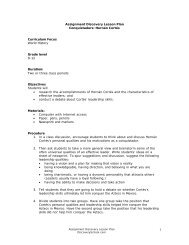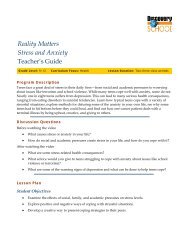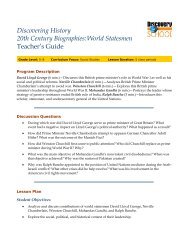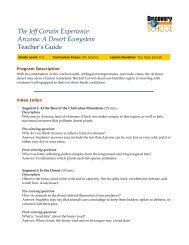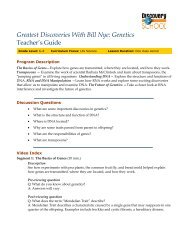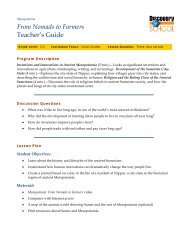Forensic Detectives: Chemistry At Work - Discovery Education
Forensic Detectives: Chemistry At Work - Discovery Education
Forensic Detectives: Chemistry At Work - Discovery Education
You also want an ePaper? Increase the reach of your titles
YUMPU automatically turns print PDFs into web optimized ePapers that Google loves.
<strong>Forensic</strong> <strong>Detectives</strong>: <strong>Chemistry</strong> at <strong>Work</strong>: Teacher’s Guide<br />
Grade Level: 6-8 Curriculum Focus: <strong>Forensic</strong> Science Lesson Duration: Four class periods<br />
Program Description<br />
From crime-scene clues to pyrotechnic beauty, there’s wonder and power in the molecular makeup<br />
of substances. Segments cover methods of analysis, chemical reactions, the periodic table of the<br />
elements, and the significance of carbon. This presentation uses fascinating examples to reinforce<br />
the roles and importance of chemistry in today’s world. This program includes one feature<br />
segment and three short segments.<br />
Onscreen Questions<br />
• What is the periodic table of elements?<br />
• How do forensic detectives use chemistry to examine evidence?<br />
• What is a chemical reaction?<br />
• What are some uses of carbon??<br />
Lesson Plan<br />
Student Objectives<br />
• Discuss the definition of chemistry and the different careers related to chemistry.<br />
• Talk about how people use chemistry every day.<br />
• Research one chemistry-related career for a class presentation.<br />
Materials<br />
• <strong>Forensic</strong> <strong>Detectives</strong>: <strong>Chemistry</strong> at <strong>Work</strong> video and VCR, or DVD and DVD player<br />
• Computer with Internet access<br />
• Poster board, markers, colored pencils, and other materials for student posters<br />
• Paper and pencils
<strong>Forensic</strong> <strong>Detectives</strong>: <strong>Chemistry</strong> at <strong>Work</strong>: Teacher’s Guide 2<br />
Procedures<br />
1. After watching <strong>Forensic</strong> <strong>Detectives</strong>: <strong>Chemistry</strong> at <strong>Work</strong>, ask students how they would define<br />
chemistry. Help them create a simple definition, such as “<strong>Chemistry</strong> is the structure and<br />
properties of substances and how they react to one another.” or “<strong>Chemistry</strong> is about what<br />
substances are made of and how they combine.”<br />
2. Next, ask students to describe careers that involve chemistry based on what they viewed.<br />
Discuss what the following careers have in common. (They all deal with substances, their<br />
properties, and how they react with each other.)<br />
• Chemists who study the properties and reactive qualities of elements<br />
• <strong>Forensic</strong> scientists who use chemical analysis to identify or match evidence from a crime<br />
scene<br />
• Pyrotechnicians who combine chemicals that produce fireworks displays<br />
• Scientists and engineers who develop new materials<br />
3. Tell students that chemistry is involved in many careers because chemicals are the basis for<br />
many of the products we use every day, from drugs to synthetic fibers to perfume. Almost all<br />
new products, from NASA spaceflight materials to new bubble-gum flavors, depend on<br />
chemistry. Examples follow:<br />
• Chemical engineers use or make new chemicals to solve problems and find practical<br />
applications.<br />
• Materials scientists use chemicals to discover and create new materials with unusual<br />
properties, such as a strong lightweight metal or a plastic that can conduct electricity.<br />
• Pharmacists, doctors, and nurses use chemistry to understand how drugs interact with<br />
the human body.<br />
• Food scientists are involved in making new ingredients or use chemistry to test food for<br />
quality and safety.<br />
• Safety and health inspectors analyze the safety of different places, from restaurants to<br />
water treatment plants.<br />
4. Share the following list of chemistry-related careers with the class:<br />
• Agricultural chemist<br />
• Chemist<br />
• Chemical engineer<br />
• Chemical salesperson<br />
• <strong>Chemistry</strong> teacher or college professor<br />
• Environmental chemist<br />
• Food and flavor chemist<br />
• <strong>Forensic</strong> chemist<br />
Published by <strong>Discovery</strong> <strong>Education</strong>. © 2005. All rights reserved.
<strong>Forensic</strong> <strong>Detectives</strong>: <strong>Chemistry</strong> at <strong>Work</strong>: Teacher’s Guide 3<br />
• Geochemist (study chemicals in rocks)<br />
• Hazardous materials expert<br />
• Materials scientist<br />
• Medicinal chemist<br />
• Pulp and paper chemist<br />
• Safety or health inspector<br />
• Textile chemist<br />
• Water chemist<br />
5. Have students research a chemistry-related job. They may choose one listed above or another<br />
from their own research. Have them answer the following questions:<br />
General Questions<br />
• What is the purpose of this job?<br />
• What are some of its specific tasks?<br />
• What kind of education and experience is required?<br />
• In what kinds of places might people in this job work? (lab, outside, in an office, etc.)<br />
• In what types of companies do people with this job work?<br />
Personal Questions<br />
• What would you like about this job?<br />
• What wouldn’t you like?<br />
• What would be most challenging?<br />
• Do you think this job is a good fit for you? Why or why not?<br />
6. Share the following Web sites with the class. Give students at least one full class period to read<br />
about careers and select one to explore.<br />
• Chemical Careers (list of careers, background, quotes, general information)<br />
http://www.chemistry.org/portal/a/c/s/1/acsdisplay.html?DOC=vc2%5c3wk%5cwk3.html<br />
• A Day in the Life: Chemist<br />
http://www.princetonreview.com/cte/profiles/dayInLife.asp?careerID=34<br />
• A Day in the Life: Chemical Engineer<br />
http://www.princetonreview.com/cte/profiles/dayInLife.asp?careerID=33<br />
• What Do Chemical Engineers Do? (click “Job Descriptions”)<br />
http://www.aiche.org/careers/overview.htm<br />
• Chemists and Materials Sciences<br />
http://www.bls.gov/oco/ocos049.htm<br />
Published by <strong>Discovery</strong> <strong>Education</strong>. © 2005. All rights reserved.
<strong>Forensic</strong> <strong>Detectives</strong>: <strong>Chemistry</strong> at <strong>Work</strong>: Teacher’s Guide 4<br />
• Chemical Engineers<br />
http://www.bls.gov/oco/ocos029.htm<br />
• Chemical and Engineering News: Career & Employment News (from flavor and<br />
fragrance chemists to those who discover and develop drugs)<br />
http://pubs.acs.org/cen/html/career.html<br />
• Adventures of Meg A. Mole, Future Scientist (Featured chemists make household<br />
products and NASA insulation)<br />
http://www.chemistry.org/portal/a/c/s/1/acsdisplay.html?DOC=kids%5cmeg_index.html<br />
• Science & Technology: Cool Tech Jobs (See Cosmetic Chemist and <strong>Forensic</strong> Scientist)<br />
http://www.girlpower.gov/girlarea/sciencetech/jobs/index.htm<br />
• Science Knows No Boundaries (see Chemist and Food Scientist)<br />
http://www.ars.usda.gov/is/kids/scientists/scientistsframe2.htm<br />
• Going Places with <strong>Chemistry</strong> (biographies of female scientists)<br />
http://www.chemheritage.org/women_chemistry/career/career.html<br />
• BLS Career Information: Jobs for People Who Like Science (Chemist, Pharmacist)<br />
http://stats.bls.gov/k12/html/edu_sci.htm<br />
• GetTech Careers<br />
http://www.gettech.org/txt/category2_txt.asp?cat=5<br />
• Cool Tech Jobs: Cosmetic Chemist<br />
http://www.girlpower.gov/girlarea/sciencetech/jobs/cosmeticchemist.htm<br />
• Career Zone: Chemists (click “Similar Jobs” for more)<br />
http://nycareerzone.org/graphic/profile.jsp;jsessionid=819311053448876046?onetsoc=19-2031.00<br />
7. Give students a full class period to complete their research. As homework, have them create a<br />
poster entitled “If I were a...” about the profession they chose. The poster should include<br />
answers to the general questions in step 5.<br />
8. Over the next few days, have students present their posters to the class. In their presentations,<br />
they should share answers to the personal questions above. Ask students to discuss each career<br />
after a presentation, citing something that surprised them about the job.<br />
Assessment<br />
Use the following three-point rubric to evaluate students’ work during this lesson.<br />
• 3 points: Students recalled several chemistry-related careers from the program; created a<br />
thorough poster that answered all research questions; made a clear presentation with<br />
thoughtful answers to the personal questions.<br />
• 2 points: Students recalled one or two chemistry-related careers from the program; created a<br />
satisfactory poster that answered most research questions; made an adequate presentation<br />
with thoughtful answers to at least one personal question.<br />
Published by <strong>Discovery</strong> <strong>Education</strong>. © 2005. All rights reserved.
<strong>Forensic</strong> <strong>Detectives</strong>: <strong>Chemistry</strong> at <strong>Work</strong>: Teacher’s Guide 5<br />
Vocabulary<br />
• 1 point: Students recalled no chemistry-related careers from the program; created an<br />
incomplete or sloppy poster that answered few or no research questions; made an unclear<br />
presentation without answering any personal questions.<br />
chemistry<br />
Definition: The science of the composition, structure, properties, and reactions of matter,<br />
especially of atomic and molecular systems<br />
Context: <strong>Detectives</strong> often use chemistry in their work, such as when they analyze residue from<br />
guns and determine the blood types at crime scenes.<br />
engineer<br />
Definition: One who applies science to the design and development of buildings, machines, and<br />
other products<br />
Context: Chemical engineers use chemistry to solve problems and create new products.<br />
forensic science<br />
Definition: The study of evidence discovered at a crime scene and used in a court of law<br />
Context: <strong>Forensic</strong> science encompasses fingerprint and handwriting analysis, as well as close<br />
scrutiny of fibers, hair, and other evidence found at the scene of a crime.<br />
materials science<br />
Definition: The study of the characteristics and uses of the various materials, such as metals,<br />
ceramics, and plastics, that are employed in science and technology<br />
Context: Those who work in materials science work to develop new materials with unusual<br />
properties, such as a plastic that can conduct electricity.<br />
Academic Standards<br />
National Academy of Sciences<br />
The National Science <strong>Education</strong> Standards provide guidelines for teaching science as well as a<br />
coherent vision of what it means to be scientifically literate for students in grades K-12. To view the<br />
standards, visit http://books.nap.edu.<br />
This lesson plan addresses the following science standards:<br />
• Science as Inquiry: Understandings about scientific inquiry<br />
• Physical Science: Properties and changes of properties in matter<br />
• Science in Personal and Social Perspectives: Science and technology in society<br />
• History and Nature of Science: Science as a human endeavor<br />
Published by <strong>Discovery</strong> <strong>Education</strong>. © 2005. All rights reserved.
<strong>Forensic</strong> <strong>Detectives</strong>: <strong>Chemistry</strong> at <strong>Work</strong>: Teacher’s Guide 6<br />
Mid-continent Research for <strong>Education</strong> and Learning (McREL)<br />
McREL's Content Knowledge: A Compendium of Standards and Benchmarks for K-12 <strong>Education</strong><br />
addresses 14 content areas. To view the standards and benchmarks, visit http://www.mcrel.org/.<br />
This lesson plan addresses the following national standards:<br />
• Science—Physical Sciences: Understands the structure and properties of matter<br />
• Language Arts—Viewing: Uses viewing skills and strategies to understand and interpret<br />
visual media; Reading: Uses reading skills and strategies to understand and interpret a<br />
variety of informational texts<br />
• Technology— Understands the relationships among science, technology, society, and the<br />
individual<br />
Support Materials<br />
Develop custom worksheets, educational puzzles, online quizzes, and more with the free teaching tools<br />
offered on the <strong>Discovery</strong>school.com Web site. Create and print support materials, or save them to a<br />
Custom Classroom account for future use. To learn more, visit<br />
DVD Content<br />
• http://school.discovery.com/teachingtools/teachingtools.html<br />
This program is available in an interactive DVD format. The following information and activities are<br />
specific to the DVD version.<br />
How To Use the DVD<br />
The DVD starting screen has the following options:<br />
Play Video—This plays the video from start to finish. There are no programmed stops, except by<br />
using a remote control. With a computer, depending on the particular software player, a pause<br />
button is included with the other video controls.<br />
Video Index—Here the video is divided into four parts (see below), indicated by video thumbnail<br />
icons. Watching all parts in sequence is similar to watching the video from start to finish. Brief<br />
descriptions and total running times are noted for each part. To play a particular segment, press<br />
Enter on the remote for TV playback; on a computer, click once to highlight a thumbnail and read<br />
the accompanying text description and click again to start the video.<br />
Curriculum Units—These are specially edited video segments pulled from different sections of the<br />
video (see below). These nonlinear segments align with key ideas in the unit of instruction. They<br />
include onscreen pre- and post-viewing questions, reproduced below in this Teacher’s Guide. Total<br />
Published by <strong>Discovery</strong> <strong>Education</strong>. © 2005. All rights reserved.
<strong>Forensic</strong> <strong>Detectives</strong>: <strong>Chemistry</strong> at <strong>Work</strong>: Teacher’s Guide 7<br />
running times for these segments are noted. To play a particular segment, press Enter on the TV<br />
remote or click once on the Curriculum Unit title on a computer.<br />
Standards Link—Selecting this option displays a single screen that lists the national academic<br />
standards the video addresses.<br />
Teacher Resources—This screen gives the technical support number and Web site address.<br />
Video Index<br />
I. The Periodic Table of Elements (9 min.)<br />
The periodic table is the backbone of chemistry. Take a closer look at its groups and periods—and<br />
what they tell us about elements.<br />
II. Clues from <strong>Chemistry</strong> (22 min.)<br />
From pinpointing grains of sand to sniffing out accelerant, forensic investigators use chemical clues<br />
to unravel unsolved mysteries.<br />
III. Chemical Display (6 min.)<br />
Fireworks light up the night with their extraordinary colors and patterns. Explore the chemistry<br />
behind pyrotechnics.<br />
IV. Carbon Copies (9 min.)<br />
Carbon, the element most important to life on Earth, can take many forms. Discover the new uses<br />
scientists are exploring for this industrious element.<br />
Curriculum Units<br />
1. A Jeweler’s Dream<br />
Pre-viewing question<br />
Q: Why is gold so highly prized?<br />
A: Answers will vary.<br />
Post-viewing question<br />
Q: What makes gold an ideal metal for jewelry?<br />
A: Its physical properties: Gold has a low melting point, it doesn’t react with oxygen (tarnish), and<br />
as a fairly soft metal, it’s easy to craft.<br />
2. Looking at the Elements<br />
Pre-viewing question<br />
Q: What’s the most important element in the world?<br />
A: Answers will vary.<br />
Post-viewing question<br />
Q: How is the periodic table arranged?<br />
A: The horizontal rows of elements, called periods, are organized by the electrons in their atoms. As<br />
you move left to right within a period, the properties of the elements gradually change. The vertical<br />
Published by <strong>Discovery</strong> <strong>Education</strong>. © 2005. All rights reserved.
<strong>Forensic</strong> <strong>Detectives</strong>: <strong>Chemistry</strong> at <strong>Work</strong>: Teacher’s Guide 8<br />
columns of elements are called groups. The elements in each group have similar chemical<br />
properties.<br />
3. <strong>At</strong>oms and Elements<br />
Pre-viewing question<br />
Q: What known element is the most reactive?<br />
A: Answers will vary.<br />
Post-viewing question<br />
Q: What is the makeup of an atom?<br />
A: All atoms have the same make-up—electrons surrounding a central nucleus, which is composed<br />
of particles called protons and neutrons. Electrons carry a negative electrical charge. Protons are<br />
positively charged. Neutrons have a neutral charge.<br />
4. Mysterious Balloons<br />
Pre-viewing question<br />
Q: What’s the most unusual object you’ve seen in the sky?<br />
A: Answers will vary.<br />
Post-viewing question<br />
Q: Why did the military suppress news about the balloons?<br />
A: Answers will vary.<br />
5. Balloon Bomb Science<br />
Pre-viewing question<br />
Q: Who would you guess was sending the balloon bombs?<br />
A: Answers will vary.<br />
Post-viewing question<br />
Q: How did the balloon bombs work?<br />
A: When released, the balloons floated upward. As the sun heated a balloon, it would expand and<br />
rise. But if it expanded too much, it could burst, so a valve opened that would release excess<br />
pressure. As night fell and a balloon cooled, it would descend. But if it dropped too much, it could<br />
crash. To prevent this, an altimeter closed a switch that ignited a charge. The blast released a pair of<br />
sandbags, lightening the load and sending the balloon back up. When all the sand bags had been<br />
released, a final charge would release the bomb.<br />
6. Stopping the Bombs<br />
Pre-viewing question<br />
Q: What can you tell by looking at grains of sand?<br />
A: Answers will vary.<br />
Post-viewing question<br />
Q: How did the sand in the balloon bombs help geologists locate their origin?<br />
A: The sand lacked coral fragments and granite, one of the most common rock types on Earth. It<br />
had high concentrations of rare volcanic minerals and microscopic plant and animal fossils. The<br />
Published by <strong>Discovery</strong> <strong>Education</strong>. © 2005. All rights reserved.
<strong>Forensic</strong> <strong>Detectives</strong>: <strong>Chemistry</strong> at <strong>Work</strong>: Teacher’s Guide 9<br />
absence of coral ruled out all beaches south of the 35th parallel; coral is almost always found in the<br />
warm waters that wash these beaches. The absence of granite eliminated other beaches. The<br />
volcanic minerals led the geologists to the peninsula east of Tokyo, and the microscopic fossils to<br />
Ichinomiya/Sendai.<br />
7. Investigating Arson<br />
Pre-viewing question<br />
Q: Why do people commit arson?<br />
A: Answers will vary.<br />
Post-viewing question<br />
Q: What are the drawbacks of using animals for arson investigations?<br />
A: Answers will vary.<br />
8. Dog Senses<br />
Pre-viewing question<br />
Q: What is a dog’s most important sense?<br />
A: Answers will vary.<br />
Post-viewing question<br />
Q: What can we learn about human olfaction by studying animal olfaction?<br />
A: Answers will vary.<br />
9. Fire in the Air<br />
Pre-viewing question<br />
Q: What are the dangers of fireworks?<br />
A: Answers will vary.<br />
Post-viewing question<br />
Q: What are the main ingredients in firework stars?<br />
A: An oxidizing agent, fuel, and chemicals that provide color. In most stars, the main fuel is the<br />
powdered form of the metal aluminum. Chemicals that add colored flames include strontium (red),<br />
barium (green), and copper (blue).<br />
10. Explosions of Light and Color<br />
Pre-viewing question<br />
Q: Are fireworks difficult to make?<br />
A: Answers will vary.<br />
Post-viewing question<br />
Q: What are the four parts of an aerial shell?<br />
A: They are: 1) the lift charge, a packet of black powder taped to the bottom of the aerial shell that<br />
provides the energy needed to propel the shell into the air; 2) the star bundle; 3) the bursting<br />
charge, which bursts the aerial shells open, ignites the stars, and pushes them outward in a pattern;<br />
and 4) the fuse, which provides the activation energy for the shell.<br />
Published by <strong>Discovery</strong> <strong>Education</strong>. © 2005. All rights reserved.
<strong>Forensic</strong> <strong>Detectives</strong>: <strong>Chemistry</strong> at <strong>Work</strong>: Teacher’s Guide 10<br />
11. Collecting Hydrocarbons<br />
Pre-viewing question<br />
Q: What are the pros and cons of drilling for oil?<br />
A: Answers will vary.<br />
Post-viewing question<br />
Q: Where does hydrocarbon come from?<br />
A: It’s produced from crude oil, found deep within Earth’s crust. To obtain hydrocarbons, oil<br />
companies drill into the layers of rock.<br />
12. Forms of Carbon<br />
Pre-viewing question<br />
Q: In what form is carbon most valuable?<br />
A: Answers will vary.<br />
Post-viewing question<br />
Q: Why makes diamonds strong and stable?<br />
A: Their carbon atoms are arranged in a crystal structure—each carbon atom is bonded to four<br />
others. Diamonds do not easily react with other chemicals.<br />
Published by <strong>Discovery</strong> <strong>Education</strong>. © 2005. All rights reserved.


